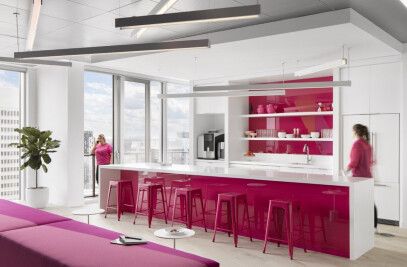Architectural glass flooring and stairs are a standout design feature in any space, and can be combined with other design elements to create amazing effects. Such was the case with the LED lit, architectural glass stairs at the Aspen Ski Lodge in Colorado. Creating an atmosphere and implementing a glass staircase design requires many facets; designers must take into account colors, light and shadow, structure and accessories.
Traction Control Ceramic Frit is used on architectural glass stair panels and glass flooring applications as it increases friction on the surface of the glass, making it highly slip-resistant. Traction Control Frit is applied using a silkscreen process, which allows for full customization of the design, including pattern and color.
Jeffrey Halferty Design architects chose a clear traction control frit and simple pattern for the floating glass stairs at the Aspen Ski Lodge, as to not interfere with the LED lights.
With glass flooring and staircase installations, safety is the highest priority next to aesthetic appeal. Before installation, all architectural glass flooring applications must be engineered to withstand the expected weight loads. Laminated glass is typically used in glass flooring as the laminated interlayer bonds the glass panels together, so that even if breakage occurs, the glass stair panels are still held together. In addition, this type of application is typically made with heat strengthened or tempered glass to increase the strength of each individual glass panel, and improve the overall safety of the installation.
The LED glass stairs in Aspen Colorado were triple-laminated and tempered, which provided superior strength and a beautifully layered side profile. The brilliant LED back-lighting cycles through a selection of colors that are displayed vibrantly in the multiple tiers, giving an impression that the glass itself is illuminating the space.
































